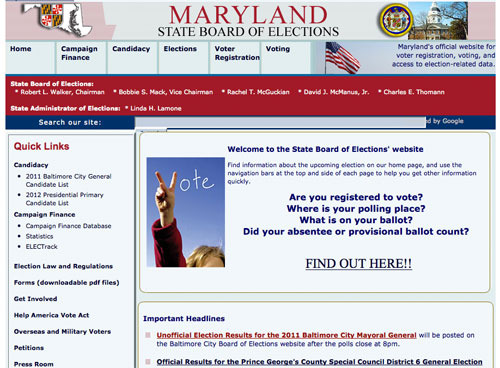By Megan Poinski
[email protected]
Maryland has the second-best state election website in the nation, according to a report by the Pew Center on the States.
The report – represented on the Pew Center’s website by a series of interactive charts and lists – ranks election websites based on how easily they can be used, how easy it is to search for information, and what kind of basic information was included. Maryland’s two election sites got a score of 84 out of 100, behind only Montana Minnesota.
“I do think the site reflects the election agency’s dedication to serving voters,” said Kim Alexander, the president and founder of the California Voter Foundation, and the lead researcher on the study.
The study looked at only each state election website and the information presented there. It did not consider campaign finance disclosure websites. Alexander said that the study’s criteria came from a group of experts working on behalf of the Pew Center, the California Voter Foundation, the Center for Governmental Studies, and the Nielsen Norman Group.
Maryland got top marks for having easy-to-find sections for voters to look up the information they are most often looking for:
· Whether they are registered to vote
· Where their polling place is located
· Getting a customized sample ballot
· Checking on the status of submitted absentee and provisional ballots
Alexander said that the Maryland site not only has all of this information, but it also looks up polling places by address. Many state sites don’t do that, she said, instead looking up polling location information by first accessing a voter’s personal information.
Other areas where Maryland’s site was lauded include:
· A layout and page flow that is easy to follow and makes sense.
· Information about how to register to vote and where to go to do it. This information also includes facts about eligibility, residency requirements, voter identification information, polling place hours, and how to complete a ballot.
· Information on provisional voting.
· Opportunities to bypass navigational links to go straight to the main content, which is important for users who have vision problems.
· Lists of candidates for state and federal offices, including links to get campaign finance information for both kinds of races.
· Ballot measure text and summaries.
· The “Rumor Control” feature, where the state board debunks any untrue or confusing information that is being spread.
While Maryland ranked well, the report says there are still some improvements that can be made. It does not include:
· Information for voters in hospitals and long-term care facilities.
· Information on what voters can do if their absentee ballot does not arrive, or if those ballots are damaged en route.
· A nonpartisan analysis of ballot issues.
· A dedicated telephone help line number.
· Circumstances under which voter information can be kept private. Even if a state does not allow this, Alexander said it’s a good practice for that fact to be included on the website.
Ross Goldstein, deputy administrator of the State Board of Elections, said that it feels great to be recognized for its website.
“We want to make the information easily accessible and make it intuitive,” Goldstein said.
Goldstein said the site has had its current design and format for about four years, but new features and functions are always being added. One of the more recent additions is making more information about state and federal election laws easier to find.
The site is likely to get more tweaks and features as the 2012 election season gets rolling, he said. And one improvement Goldstein hopes to add before next November is making election night results easier and faster to access.






Recent Comments